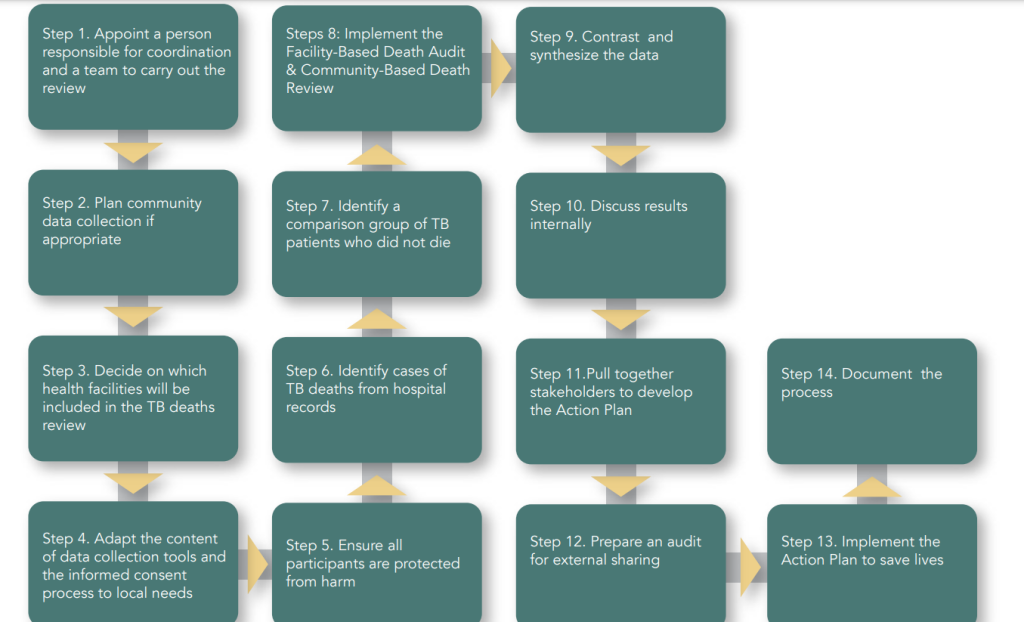Content Status
Type
Linked Node
Death Audit
Learning ObjectivesDefinition, importance, process, format
A death review or mortality audit is a means of documenting the causes of death and the factors that contributed to it, identifying factors that could be modified and actions that could prevent future deaths, putting the actions into place and reviewing the outcomes.
The aims of the audit or review of deaths in hospitals and health services are to:
- Ensure that all deaths are identified and discussed, and confidentiality is maintained.
- Assign a cause or causes to each death.
- Determine whether the care given was consistent with evidence-based clinical practice, standards of care or the care desired by professionals.
- Determine the social, environmental and nutritional risk factors for any death.
- Determine possible modifiable factors in the care of each person who dies.
- Change modifiable factors to improve the quality of care and avoid similar deaths in the future.
- Improve the quality and completeness of patient documentation.
- Provide an opportunity for reflection and support to HCWs.
- Let families know that their relative’s life was valued, the death is being taken seriously and HCWs are committed to learning and improving their practice.
Under the National TB Elimination Programme (NTEP), death audits provide insights into the chain of social, economic and clinical events leading to TB deaths and guide the programme in taking appropriate actions to prevent them.
Process for Undertaking Death Audits
An overview of the process for undertaking a TB death audit is shown in the figure below. Under NTEP, the following stakeholders are involved in the process:
- The medical officer should conduct an in-depth audit of all the deaths occurring amongst TB patients irrespective of initiation of treatment.
- Similarly, the District TB Officer (DTO) should conduct the death review of all Multidrug-resistant TB (MDR-TB) patients who died.

Figure: Overview of the process for undertaking a TB death audit
Resources
- Training Modules (1-4) for Programme Managers and Medical Officers, 2020.
- A Guide to Conducting TB Patient Mortality Audits using a Patient-centered Approach, KNCV, USAID and MSH, 2012.
- Operational Guide for Facility-based Audit and Review of Paediatric Mortality, WHO, 2018.
Assessment
| Question | Answer 1 | Answer 2 | Answer 3 | Answer 4 | Correct answer | Correct explanation | Page id | Part of Pre-test | Part of Post-test |
| Which of the following is true about death audits? | A death audit is a means of documenting the causes of death and the factors that contributed to it. | It helps in identifying factors that could be modified and actions that could prevent future deaths. | It can be conducted via a community-based death review | All of the above | 4 | A death review or mortality audit is a means of documenting the causes of death and the factors that contributed to it, identifying factors that could be modified and actions that could prevent future deaths, putting the actions into place and reviewing the outcomes. It is conducted via two main methods: Community-based Death Review and Facility-based Mortality Audit. | Yes | Yes | |
| Which of the following stakeholders are responsible for conducting death reviews under NTEP? | Treatment supporters | Medical officers | State TB officers | None of the above | 2 | The medical officer should conduct an in-depth audit of all the deaths occurring amongst TB patients irrespective of initiation of treatment. | Yes | Yes |
Page Tags
Content Creator
Reviewer
Target Audience
- Log in to post comments